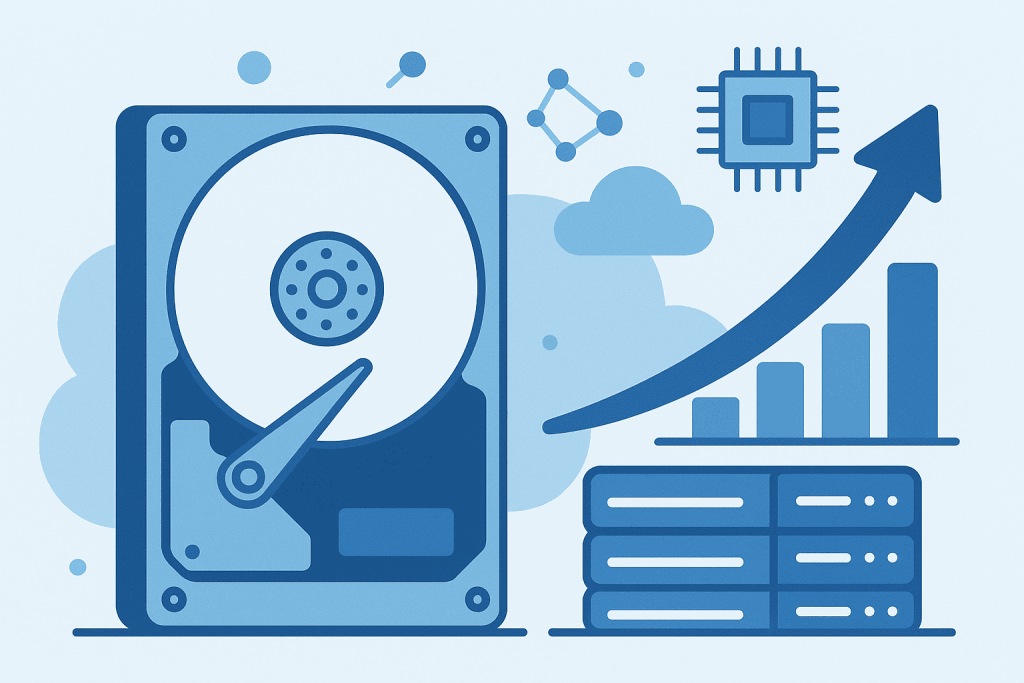
While the world is rapidly shifting toward solid-state drives (SSD), Toshiba has proven that traditional hard drives (HDD) are far from obsolete. In autumn 2025, the company announced a major breakthrough — the creation of a technology that allows 12 magnetic platters to fit inside a standard 3.5-inch drive casing. This enables capacities of up to 40 terabytes (TB) per drive — a record for its class.
This achievement doesn’t just expand storage capacity — it redefines what an HDD can be. Despite predictions, hard drives remain indispensable wherever massive volumes of data must be stored — in data centers, cloud storage, and enterprise backup systems.
Why HDDs Still Matter
Despite the popularity of SSDs with their blazing speed, HDDs retain one unmatched advantage — the cost per terabyte. For companies managing petabytes of data, saving just a few cents per terabyte translates into millions of dollars each year.
That’s why HDDs remain the foundation of infrastructure for Amazon, Google, Microsoft, and others. They use them for “cold” storage — data accessed infrequently but that must remain available. Toshiba’s innovation confirms that this technology still has plenty of room to grow.
How Toshiba Achieved 12 Platters
Modern HDDs typically contain up to 10 platters — thin magnetic disks responsible for reading and writing data. Toshiba managed to fit 12 by replacing the usual aluminum platters with a glass substrate. Glass is lighter, stronger, and more resistant to temperature changes, allowing thinner platters without losing rigidity. This reduces vibration and improves spindle balance.
Engineers also redesigned the internal mechanics: they developed an improved air-stabilization system to prevent turbulence and enhanced the drive’s sealing — since modern HDDs are often filled with helium, which reduces friction and power consumption.
MAMR — A Magnetic Breakthrough
Another key technology behind the 40 TB drive is Microwave-Assisted Magnetic Recording (MAMR).
During writing, the drive head emits a microwave signal that temporarily “softens” the magnetic field, making it easier to switch polarity. This enables higher recording density, lower energy use, and greater reliability.
Toshiba’s combination of MAMR and 12-platter architecture paves the way for 40 TB drives expected by 2027.
Who Needs These Drives
Primarily enterprise users. In data centers, efficiency is measured not just in speed but also in storage density — how much data fits in a single rack unit. Each extra terabyte means fewer drives, less power, and lower cooling costs. Toshiba plans to introduce the technology in its MG-series enterprise drives, widely used by cloud providers, and later in NAS systems for home or office use.
Competitors and the Race Ahead
Seagate is promoting its own technology, HAMR (Heat-Assisted Magnetic Recording), in which magnetic domains are “heated” by a laser before writing. This approach can potentially deliver even higher recording density, but it comes with a more complex design and higher production cost.
Western Digital, in turn, also plans to release drives with capacities exceeding 40 TB and is developing ePMR (Energy-Assisted PMR) — an enhanced version of conventional magnetic recording that uses a small electric field during data writing. This helps switch magnetic particles more precisely, allowing more information to be written without overheating or compromising reliability.
All these approaches aim for the same goal — reducing the cost of data storage. And Toshiba has chosen a balance between innovation and reliability: its solution appears simpler and potentially more cost-effective to manufacture.
Why It Matters for Users
Although 40 TB drives will debut in data centers, technology always trickles down. Just as SSDs once cost hundreds of dollars for a few gigabytes, future consumer HDDs of 30–40 TB may become commonplace — ideal for archiving video, photos, backups, or running personal media servers.
Conclusion
Toshiba’s technological leap is more than another capacity milestone — it’s proof that HDDs are alive, evolving, and innovating. With 12-platter architecture, glass disks, and MAMR technology, Toshiba has shown that hard drives can be both affordable and high-tech.
While SSDs dominate fast computing, HDDs remain the backbone of the digital world — and Toshiba is shaping what that world will look like in the decade ahead.

Leave a Reply